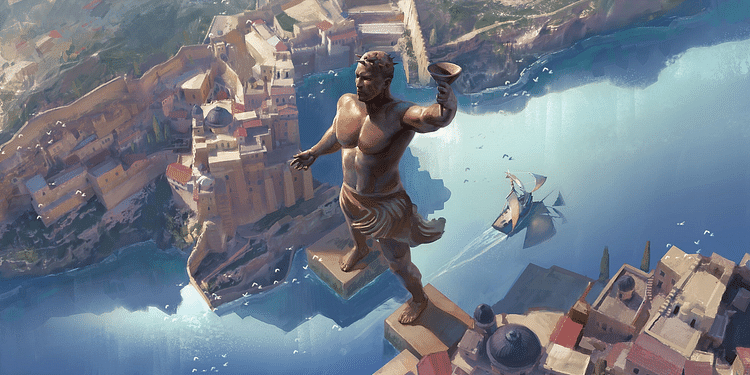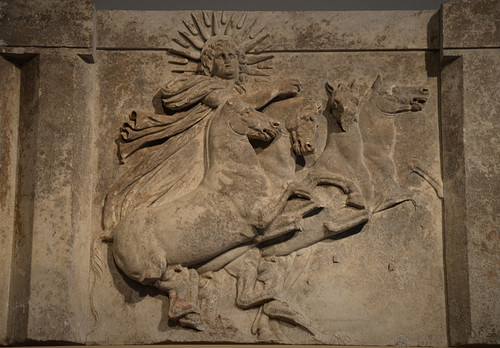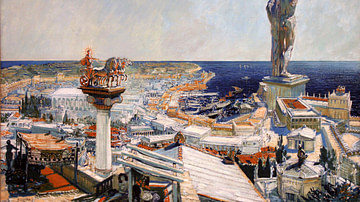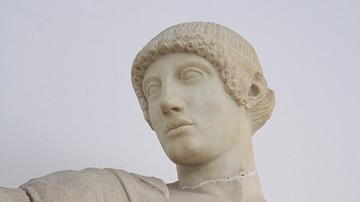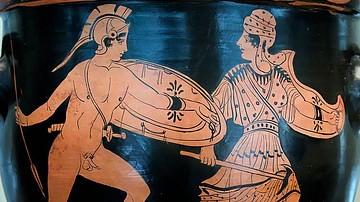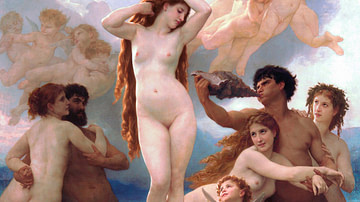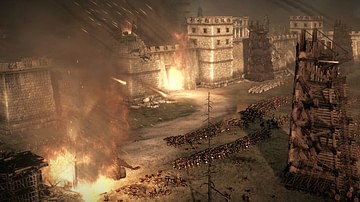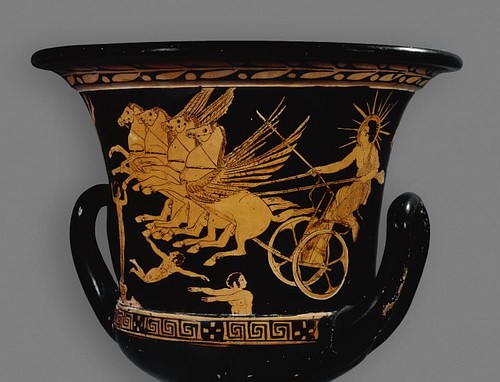
Helios (also Helius) was the god of the Sun in Greek mythology. Helios rode a golden chariot which brought the Sun across the skies each day from the east (Ethiopia) to the west (Hesperides). Helios was famously the subject of the Colossus of Rhodes, the giant bronze statue considered one of the Seven Wonders of the Ancient World.
Helios in Mythology
In Greek mythology, Helios is the offspring of the titans Hyperion and Theia. His sisters were Selene (the Moon) and Eos (Dawn). Hesiod informs us in his Theogony that with Perseis, daughter of Ocean, he had two children, Circe and king Aietes, who ruled at Kolchis. Later, Apollodorus adds Pasiphae too. Helios is also the father of Phaethon, whose mother was Clymene. When the youngster discovered that his father was the Sun he went to him in the east and asked for a gift. Helios offered him anything he wished, and Phaethon asked if he could ride his father's blazing chariot across the sky. Helios consented, but the favour turned into a tragedy when Phaethon proved unable to control Helios' wild horses, and when he spun out of control, Zeus was obliged to strike down Phaethon with a thunderbolt lest he set the whole world on fire.
Helios pops up in several other Greek myths, albeit in mere cameo appearances. The Sun god shines on the amorous couple Aphrodite and Ares revealing to Hephaistos the illicit shenanigans of his wife in the trap he had set. Helios also appears in the Hercules myth when the hero was performing his 10th labour to fetch the cattle of Geryon from Erytheia in the far west. Fed up with the burning sun on his outward voyage, Hercules threatened to fire one of his arrows at Helios. The god, rather than punish Hercules for his petulance, rewarded his daring by gifting him a golden bowl which he used to sail the seas in greater comfort. The bowl must have been a large one because when the hero gathered together the cattle he herded them into the bowl and brought them back to Mycenae that way. When home safe again, he returned the bowl to Helios with gratitude.
The famous sacred cattle of Helios, which he kept on Thrinacia (perhaps Sicily or Malta), were stolen once by the giant Alkyoneus, an outrageous act which was avenged by Hercules. Helios again had some of his flock attacked, and this time eaten too, by the hungry comrades of Odysseus on their long voyage home from the Trojan War. In vengeance, Helios enlisted the help of Zeus who destroyed the ship and drowned Odysseus' crew for their impiety.
Cults & Worship of Helios
The god was not the subject of a wide-spread cult, but Plato informs us in his Symposium and other works that many people, including Socrates, would greet the Sun and offer prayers each day. More direct and ceremonial worship of the Sun was, in fact, held by the Greeks as a point of distinction between other races and themselves, they did not indulge in it while 'barbarians' did. Still, despite being one of the minor gods, the 5th-century BCE philosopher Anaxagoras of Clazomenae did cause outrage when he said that, according to his calculations, the Sun was not a god but a huge burning rock.
The one place in Greece where the worship of Helios was important was on Rhodes. In its founding mythology, the name of the island derives from the nymph Rhodos who bore seven sons to Helios, the patron of the island. Three grandsons of these offspring were the heroes of the three principal cities on the island: Camirus, Ialysus, and Lindus, which were named after them. In honour of Helios, Panhellenic games, the Halieia, were held on the island every five years, and each year a chariot and four horses (quadriga) were thrown into the sea as an offering to the god. The famous bronze statue of Helios known as the Colossus of Rhodes was considered one of the Seven Wonders of the Ancient World. At 33 metres high, the massive standing figure of Helios dominated the harbour of the city. Built between 304 and 280 BCE, it was toppled by an earthquake in either 228 or 226 BCE.
The god Apollo was linked with the Sun from the 5th century BCE, and the association became ever stronger from the Hellenistic period, largely thanks to the influence of Greek philosophers who began to give more importance to celestial bodies. Apollo and Helios then became almost synonymous, just as Hyperion and Helios had been in the Archaic period. The Romans went one step further and made Helios, also known as Sol, an important cult god. Rome's Circus Maximus, for example, had a temple dedicated to Sol and Luna (the Moon) from the 3rd century BCE. The worship of Sol gained greater importance in the imperial period, especially during the reigns of the 3rd century CE emperors Elagabalus and Aurelian. The latter was even the son of a priestess of the Sun. A dedicated priesthood, known as the pontifices Solis, managed what was now the most important imperial cult, a position it would hold until replaced by Christianity.
How is Helios Represented in Art?
Helios appears in all forms of Greek and Roman art, where he is usually depicted as a youth wearing a crown of sun rays. Helios is often in the background or edge of scenes in Greek pottery decoration riding his golden chariot, but in one red-figure kalyx-krater (c. 420 BCE), now in the British Museum, he takes centre stage whilst before him young male children representing the stars descend into the ocean as he approaches. Most often Helios' chariot is pulled by winged horses but sometimes dragons do the job, as in a c. 400 BCE red-figure krater from Lucania which shows his granddaughter Medea at the reigns. Helios also frequently appeared on 6th-century BCE black-figure and 5th-century BCE red-figure pottery in scenes from the Hercules story, again usually riding his golden chariot in the background. The god was, for centuries, also depicted on the coins of his patron city Rhodes.